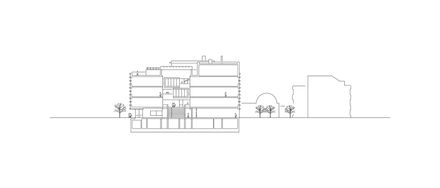
Center of Brain, Behavior and Metabolism
ARCHITECTS
Hammeskrause Architekten
AREA
13200.0 m²
YEAR
2016
PHOTOGRAPHS
Werner Huthmacher
CATEGORY
Research Center, Institute
LOCATION
Lübeck, Germany
CLIENT
Federal State of Schleswig-Holstein
REPRESENTATIVE OF THE CLIENT
Gebäudemanagement Schleswig-Holstein AöR (GMSH)
PLANNING AND CONSTRUCTION MANAGEMENT
Hammeskrause Architekten
CONSTRCUTION COSTS
30.91 million Euros
PROJECT TEAM LUBECK
Wahrmann, Tal’at Mutlu, Martin Grebniok, Ole Küstermann
OVERALL COSTS
38.24 million Euros
PROJECT TEAM STUTTGART
Markus Hammes und Nils Krause, Jürgen Naverschnigg, Christiane
Text description provided by architect.
The international research building Center of Brain, Behavior and Metabolism (CBBM) at the University of Lübeck provides 320 scientists, doctors and students with space for research in the fields of brain, hormones and behaviour.
The new building comprises on 5,400 square meters of floor space biomedical laboratories, sleep laboratories and glucose clamp units for three institutes - the Institute for Neuroradiology, the Institute for Neuroendocrinology and the Institute for Pharmacology.
The rectangular volume of the CBBM with its characteristic, horizontal façade strips harmoniously blends in with the university campus and creates an identity-generating centre for the three institutes.
The transparent entrance zone opens up towards Marie-Curie-Straße and affords views into the foyer with its multi-functional seminar and event area.
Lectures, colloquiums, laboratory course as well as symposia and scientific congresses will be held here in the future.
Two bright atriums immersed in light form the communicative centre of the CBBM and are connected via a large bridge and several stairways in the centre of the building. Seating groups and tea kitchens in the atriums invite the scientists to get together in informal meetings, thus promoting the interdisciplinary exchange among the different work groups.
The fully glazed laboratory clusters, sleep laboratories and glucose clamp units are arranged all-around and provide generous insights into the work of scientists. Four seminar rooms, three of which can be divided, are assigned to the multi-functional foyer on the ground floor.
On the upper levels, four glazed meeting rooms are “suspended” in the void. Further seating corners with bar stools, benches and tea kitchens are distributed on the gallery levels – these areas afford a generous view into both building sections.
Besides the high functional demands on the building, the concept of the new building also considers aspects of interdisciplinary research.
The CBBM coordinates joint research projects and is dedicated to the promotion of young researchers. “The scientists can spontaneously get together in the atriums, which are designed as meeting points. Research is not generated on the drawing board but during coffee breaks and when exchanging ideas with colleagues”, explains Markus Hammes from hammeskrause architekten and adds: “Room for communication is a necessary component of a sustainable building concept, and the CBBM is a future-oriented example of this”.
The new CBBM building is a research complex conceived to achieve above-average energy efficiency. The legal requirements of the Energy Savings Ordinance ENEV 2009 are undercut by about 30 percent.
The layout of the energy-intensive laboratory landscapes at the roofed atriums achieves a very favourable ratio of exterior surface to volume.
Buildings and technical installations are oriented by the passive house standard.In the immediate vicinity of the CBBM Brain Centre, the Inflammation Center “Biomedical Research” BMF for about 350 scientists, which was also designed by hammeskrause architekten, has been under construction since 2015.
The architectural proximity of these two research foci is a great opportunity for science. After the completion of the BMF, both buildings will be interlinked internally, and the entrance foyer of the CBBM will then also provide access to the future Inflammation Center.














